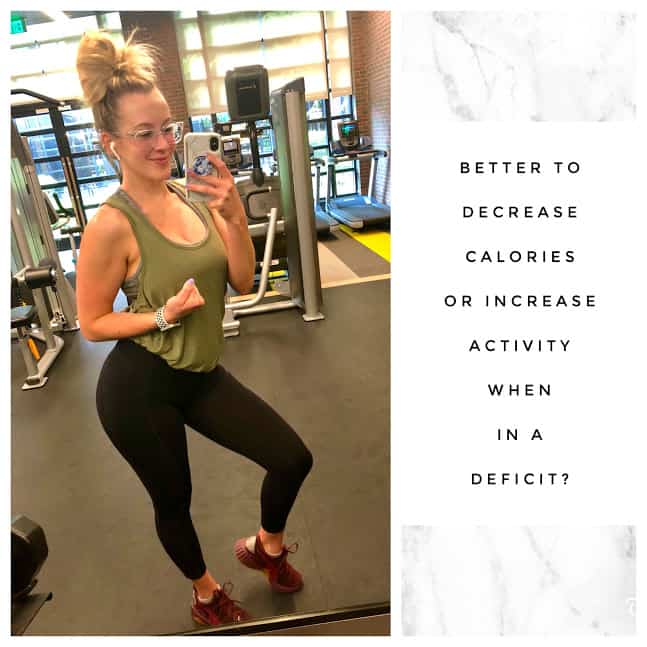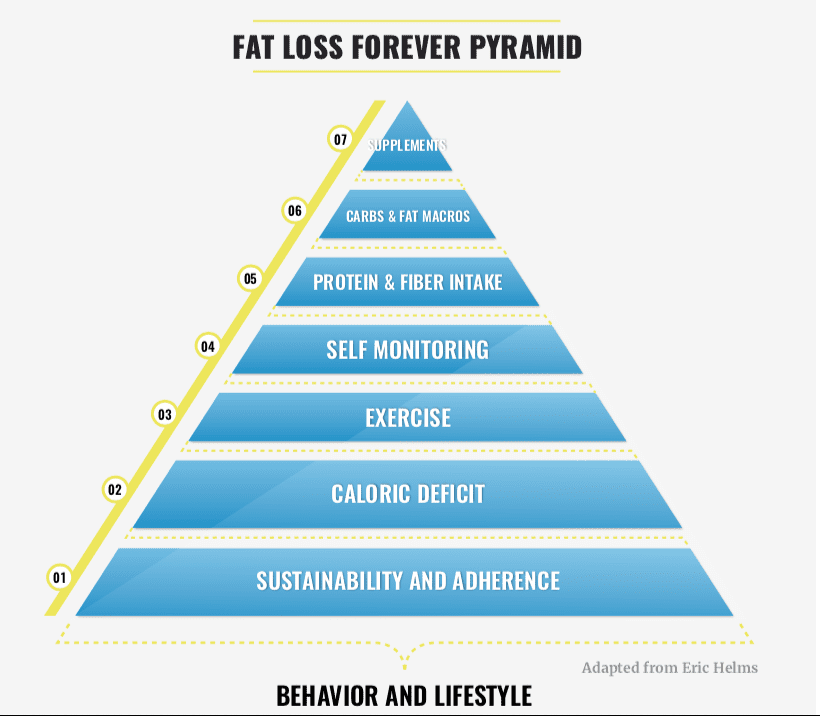This post may contain affiliate links. Please read my disclosure policy.

We know now that in order to lose fat, we must be in a calorie deficit.
But just as we discussed in previous posts, this “calorie deficit” is continuously changing as our metabolism adapts to the decreased intake and increased activity we’ve taken on and become accustomed to.
To explain this better, say Amy started her diet eating 2000 calories. Her previous maintenance was 2200 calories, so by eating 2000 calories a day, she created a deficit, and was able to lose weight.
A few weeks or a month pass, and Amy stops seeing results. No more weight loss, no more change in progress pics.
Amy’s metabolism has adapted to the decreased calories she’s been eating.
Her new maintenance calories is now 2000 calories; and in order to continuing seeing fat loss, she must create another deficit.
This deficit can be created in one of two ways:
1. Decreasing calories further, or by
2. Increasing activity
So which is better?
We will examine both options, but I just want to preface and say, the answer will always be “it depends.” It depends on which option is more sustainable for you — to keep up with week after week, to continue seeing results, until the end of our diet. Sustainability and consistency are what matters MOST. So let’s examine the PRO’s and CON’s of both.

1.) Decreasing calories further:
For most people, this seems to be the easier option to pick. Especially if you are not a fan of cardio. But just like both options, it does come with its setbacks.
The PRO’s:
-Physically, it’s the easier option to do.
-It requires less time spent working to complete added activity.
The CON’s:
-Decreasing calories further, means decreasing metabolism further (i.e. gradually making it harder to burn calories and decreased NEAT – non-exercise activity thermogenesis).
-There’s only so much you can decrease calories before it can become unsafe and damaging to your metabolism.
–Restricting food further also leads elevated levels of ghrelin, a hunger hormone, and lower levels of peptide YY, a hunger-fighting hormone.
2.) Increasing Activity
This can be done in a couple of ways. Increasing steps, adding in a prescribed cardio regime (in the form of minutes, miles, calories burned; doesn’t matter which, you just need to stay consistent with how you track it so that you can most accurately adjust as you need to make changes in the future).
The PRO’s:
-Exercise has been shown to increase levels of peptide YY – meaning less hunger, and less cravings.
-By adding exercise, you get to still eat higher calories while still creating a deficit to lose fat.
The CON’s:
-Just with decreasing calories, there’s only so far you can go with increasing activity.
-Requires more of a time commitment to get done.
In one study done by the School of Sport, Exercise and Health Sciences at Loughborough University, researches tested the differences between adapting an increase in activity vs. decreasing calories. Researchers found that the participants who restricted calories further “demonstrated rapid and robust compensatory appetite, energy intake, and appetite hormone responses (acylated ghrelin and PYY3–36) to energy deficits induced by food restriction but not exercise.”
All of this just means that decreasing calories (as opposed to increasing activity) can increase appetite and hunger hormones, making individuals more prone to having less energy, suffering more hunger, and making them more likely to overeat/binge, as opposed to their exercise counterparts.

Conclusion:
To restate — these hormonal changes in appetite vs appetite suppression are the key differences between the two options. What ultimately matters is creating a calorie deficit, and this should be done in whichever way is the most SUSTAINABLE for YOU.
Will you be able to keep up eating that low calories for the duration of the diet? Will you be able to keep up with the added exercise that you have just added to your current exercise regime?
These are the questions you need to ask yourself.
Suggestions:
I’ve found an initial conservative decrease in calories and modest increase in activity to work best for me. But everyone is different when it comes to their lifestyle and what they are capable of doing and sacrificing. A combination of both, with room to make changes as needed, will likely lead to the best results.
- I would first recommend to begin increasing your number of steps each day. Go on a couple of extra walks in the middle of the day, park the car farther away. These extra steps add up and are a great way of increasing calories without feeling like you are doing so.
- Add in cardio gradually. Cardio is a tool and should be utilized as one. If you haven’t been doing any cardio, don’t jump right into to 30 minute runs 5 days/week. Your body will adapt to this, so start with 2, and gradually increase, giving yourself room to keep using it as a tool and seeing results.
- Don’t decrease calories too much from the get go. Again, you won’t have any room to make changes later if you start with a huge calorie drop. Gradually decrease your calories as needed when you plateau to keep seeing results.
- Make sure you have a strong metabolism and are eating a high number of calorie as your maintenance before you start your diet. If you’re currently eating 1400 calories a day, doing cardio 5 days/week and are looking for continued fat loss, there isn’t much more room to push yourself. Take time to reverse diet and get your metabolism in an ideal place, eating a good amount of calories before you decide to diet again. I started my most recent diet eating 2200 calories! Starting with a high number of calories will make it not only easier for you to see results, but also make it possible for you to keep getting results longer. This will be the most important thing you can do!
I hope this article was able to share some insight for those of you dieting and trying to decide which option is better! <3
Until next time,

References:
- https://journals.lww.com/acsm-msse/Fulltext/2016/03000/Appetite_and_Energy_Intake_Responses_to_Acute.10.aspx
- Fat Loss Forever, by Layne Norton
